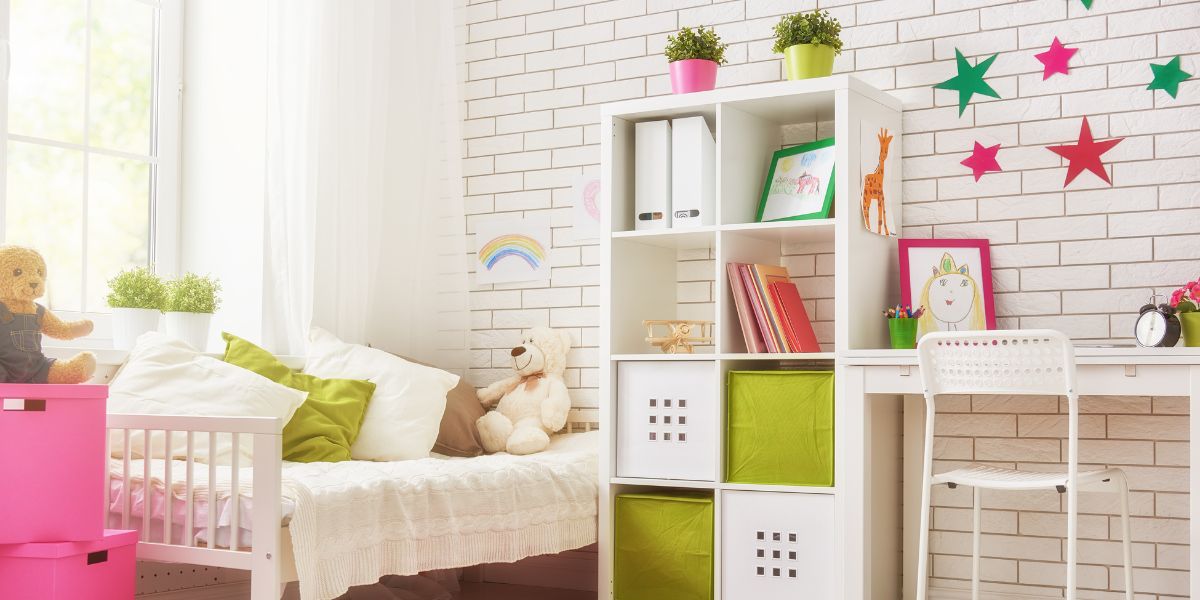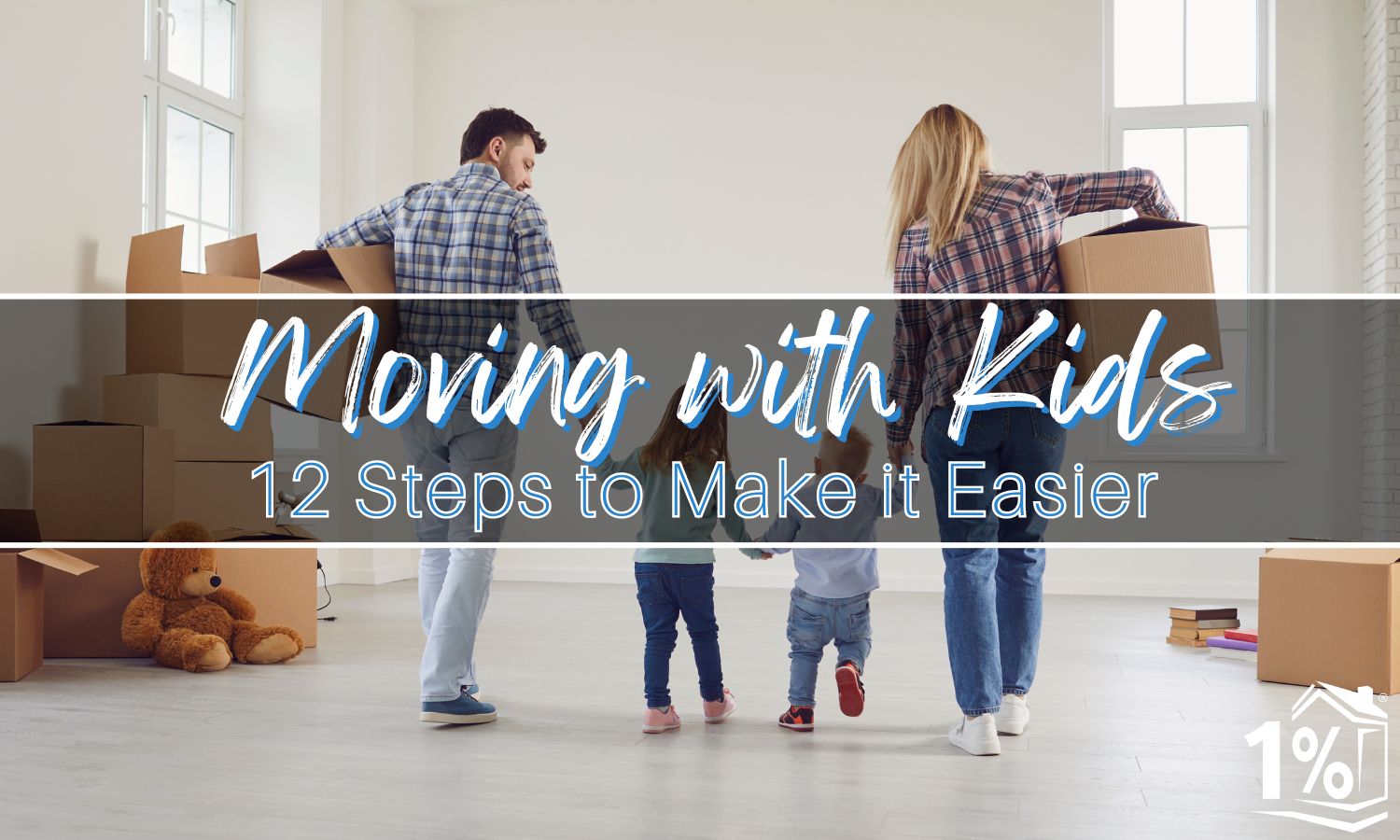It is a difficult job to move. You have to not only pack all your things, but also find a moving company, clean your old, and organize your new one. Even if you’re moving alone, it can be a difficult task. Add kids to the equation and the job can start to seem insurmountable. That’s because moving with kids (and moving with pets) add a whole new element to the moving process.
Any child can find moving to a new town or city overwhelming. In the midst of the packing chaos, children are forced to say goodbyes to their friends, teachers and the comforting familiarity of their community.
Children may find that they are behind their peers in a new classroom after moving. Some children have difficulty making new friends and worry about being the “new kid”.
There are, however, things that you can do to drastically improve the moving experience for children of all ages. So before you sell your home, keep reading! We’re gonna dive into 12 different steps you can take to make moving with kids easier.
Step 1: Be transparent
Honesty is the first tip for moving with kids. As soon as you have finalized your plans, tell your children why and when they’ll be moving. Use age-appropriate terminology. Maybe this is a relocation due to a new job. Or perhaps you’re moving closer to your family. Inform the children in a simple and direct manner.
Children have a sixth-sense that can detect even the smallest changes in the household atmosphere. Instead of waiting until the perfect moment, just tell them. You can add the topic to your next family meeting or go for a walk and talk break. Give them a moment to process the information and absorb it. You’ll make the move easier for everyone if you keep them informed about your plans and update them at every stage. Bonus: This will help you gain trust, which is rare in those sometimes difficult teenage years.
Certain situations require a delicate touch. Consider the relationship between your child and your partner before you decide how to approach this conversation. Moving in together can be exciting but also stressful. Moving in with children adds another dimension.

Step 2: Get your children involved with the move
Enlist your children to help you with the moving process. It’s a big family affair.
Here are some ideas to involve your kids in the move:
- As you search for a new home in your town, give your children the opportunity to vote. You can do this by looking through photos together online to narrow down your search, or you can take them with you on a tour of new homes. Find out how they would like their rooms to look. What about the yard or garden? Has a treehouse always been on their wish list? Do they want a pool? Consider their opinion, their pros and cons, and their suggestions when you make your choice. Keep the dream house exercise grounded in reality. You don’t want your children to be disappointed if they can’t get the hillside castle complete with ponies and an amusement park in the backyard.
- Send them into their room with some boxes to pack. Give your children ownership of their move – again, in an age-appropriate manner, of course – to help them feel more involved and make the transition easier. You can do the same on the other side: Let them lead the unpacking of their new room. Ask them where they would like to hang posters and pictures, and how to best arrange furniture.
- Let your children be decorators. Let them choose the colors of paint and pillowcases for their new bedroom . Even the grumpiest tweens will smile when they can choose their own new items. You don’t need to spend a fortune – a few small touches can transform the look of the space. A signature piece could be based on a favorite character, movie or sports theme. It’s okay if your child wants to recreate his or her old bedroom. It’s important that you support your child, make them comfortable and help them adjust to the new house. But you also want to find a balance to help them accept the realities of the move.
Step 3: Take your kids on a trip to your new town
Negotiate moving your family along with you. Include a trip to your new city in your relocation package if you are moving for work. Explore the area and look for kid-friendly sites like playgrounds, parks and the closest ice cream shop. Your children will feel more comfortable in their new city if they are familiar with the local attractions. If you hired a real estate agent in your new town, they should be able to help with learning more about that community and would probably be happy to help.
Step 4: Get involved in you new community
Joining a club or organization that is interesting to your children (and to you!) will help to make your family feel more at home. Here are some ideas:
- Volunteer for a non-profit. Start with a neighborhood cleanup crew or food pantry. You will meet like-minded people and do meaningful work in your new community.
- Be creative. Look for arts organizations in your town to find out if you can act, paint or write in the band. Taylor Swift can attest to the fact that expressing emotions and working through problems creatively are proven methods of therapy. If your children are feeling apprehensive about moving to a new city, give them a guitar, paintbrush or blank notebook and watch what they create.
- Do you have any active kids? For energetic kids, the YMCA and local community center is a good choice. Find (or start) a game of pickup soccer to let your children unleash their inner Olympians. If you are moving with kids in the summer and the local swimming pool is the center of activity, older kids may find new friends at the YMCA.
- Extra, extra! Explore the options available to your children after school. Extracurricular activities can help students discover peers who share their interests, and even develop a new one. Encourage them to create their own club if their passion is not offered by a club. This is another great way to meet others with similar hobbies and interests.
Step 5: Connect with other parents
It’s a win for both you and your children. Use your social network to find connections. Someone always knows someone, right? Ask your new HR Director to recommend local parent groups if you are moving for a job. Moving with a Baby? Look for playgroups or weekly Storytime at the library. These gatherings provide a great way for you and your child to make new friends. This is essential to helping them settle in and feel comfortable.
Step 6: Plan a visit to the old neighborhood to see friends
Everyone loves to have something to look forward to. That’s why people start counting down the days to Christmas in July, and celebrate half-birthdays during the summer. Plan a visit to your hometown with the same excitement. It will comfort your children to know that a trip is on the horizon. In times of stress, it’s comforting to reach out to an old friend. So keeping them in your heart is the next best option. Encourage your children to keep in touch with each other via email, or even traditional letters. Remember how much fun it was having a pen pal?
Step 7: Give yourself plenty of time to prepare for the move
You’ll likely encounter many unexpected events as you wind down your time in your home. This includes friends stopping by to wish you well or neighborhood goodbye parties. There may even be the odd meltdown from one of your kids — or yourself. Add some buffer time for unexpected delays. Consider pod-style portable moving containers, which will allow you to take as much time as you want. You can move at your own speed because the containers will be outside your driveway, waiting for you to schedule their pickup and transport to your new house. What’s the best part? This allows you to focus on your children throughout the entire process.

Step 8: Make your kids’ bedrooms a priority
Packing and unpacking the rooms of your children should be done in this order: Last to pack and first to unpack. This will allow your children to spend as much time in their old rooms as possible, while also allowing them to settle into the new home right away.
Step 9: Check out the local library
Your local library is the best place to start after moving with kids. You can get your children a library card – it’s like giving them their own ID with their name on it! Then, get to work researching. Learn about your new community and make it a project. You can ask the librarian to help you find out the history of the town: who founded it? What are the main industries? How many people moved there over the last decade? Make the lesson creative by having your child create a picture book, or write a short story or poem about the town. You’re not the project type. You can probably find a summer reading program or book club (with prizes!) The summer reading program is in full swing.
Step 10: Learn as much as you can about how to make moving easier
You can find more information about keeping your family happy by reading other blogs about moving. Remember that for kids, the stress of moving is often about the unknown. So help them learn as much as they can about where you will be living. Talk about the neighborhood and the schools. If they know any family or friends that live in the area, you can talk about how it will be nice getting to see these people more frequently.
Step11: Remember that there is no “worst age to move a child”
Each age group faces unique challenges when moving from their only home. Teens and tweens may be saddened by the loss of lifelong friendships (more about that in a moment). It can be a bit nerve-wracking to be the new kid, especially if school has already begun. Toddlers who are just starting to find their feet in the world face the challenge of learning a new place and saying goodbye to familiar faces. Find new friends as soon as possible.
Talk to older children about their opportunity to broaden their horizons. Celebrate the move by going on a shopping spree, or giving yourself a mini makeover. It’s a must: Find the best coffee house in town (or their favorite restaurant) and buy them a gift certificate.
As their caregiver, you can help them turn this moving process into something positive and even exciting. Recognize the sadness and anxiety is common when moving with kids. It is also important to highlight the positive aspects of the new town. It can be a real treat to discover a new town: new shops, restaurants, parks, friends, and even interesting clubs and school activities. You may be able help your child turn their blues around by pointing them in the direction of fun activities and clubs.
Step 12: Trust your instincts
It is stressful to move at any age. Experts consider moving to be one of the five most stressful events in life. For kids, however, disruptions can have a different impact. Pay attention to your child’s mood and behavior. You know them better than anyone else. Keeping them calm and reassured will go a long way. You may not be able to pick up on subtle signals, but even the most observant parents may miss something. Check in with your child to ensure they are adjusting to the new changes.
It may be time to have a wellness or heart-to-heart break if you notice new behaviors that are worrying. For example, if you spend a lot of time alone or exhibit mood swings. Take a walk outside, start a project or snuggle on the couch to watch a movie. In times of change and disruption, a hug can be all that is needed to make you feel better. This is true for children of all ages.
Conclusion
So there you have it. 12 ways to make moving with kids easier and less stressful. Not each item on this list will apply to every situation. But now you have a great place to start from when planning your move. If you haven’t sold your home yet, make sure to look at the ways you can save money when selling your home.





